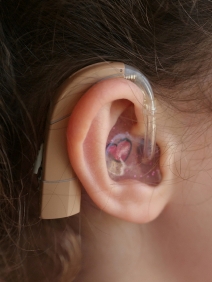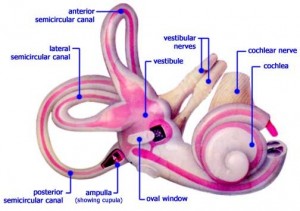
Behind the Ear Hearing Aid
http://www.hearing-aids-wizard.com/image-files/behind-the-ear-hearing-aid-decorated.jpg
One important characteristic of being human is our complexly developed senses; our senses are what place us at the top of the food chain. However, one in twenty five people in Canada are unable to experience one of the most fundamental senses for survival: hearing. Scientists have aimed to develop technology to improve the quality of life for those who are hearing impaired. There are already methods that are successful in improving hearing: the hearing aid and the cochlear implant. Furthermore, recent research suggests that embryonic stem cells could also be of great help when treating the hearing impaired.
The hearing aid is the most common type of treatment that doctors recommend for hearing loss. It is an electronic device consisting of a battery and some form of a miniature loudspeaker that amplifies sounds that the user is unable to detect. Moreover, the device is customized to the ear shape of the user and fits comfortably inside the ear. An advantage of the hearing aid is that it is cost effective; no matter the financial state of the patient, it is possible to find an affordable device. A second advantage to the hearing aid is that it comes in different styles so finding the right one depends solely on the user’s preference. Its many advantages have widely popularized the use of it for people who are hearing impaired.
Another method of improving hearing is the surgical implantation of an artificial cochlea, also known as the bionic ear. The cochlea implant functions through skipping the component of the patient’s inner ear where the fully functional hair cells used to be, and stimulating the cochlear nerves directly using electrical impulses sent by the implant. This would allow the brain to be able to receive nerve impulses the same way hair cells would send nerve impulses. The downside of the cochlear implant include risk of infection from the surgical procedure, and the high cost of the implant itself.
The last method that will be discussed was found recently by the University of Sheffield in England and involves an area of science that has been on the rise for the past twenty years: stem cell research. This new discovery suggests embryonic stem cells can be modified such that it mimics the function of a hair cell, thus, allowing the ear to hear normally. Further research must be done to implement this method but researchers at the University believe this method, when paired with the cochlear implant, possesses the ability to treat people with hearing impairment.
To demonstrate how life changing advances in science can be, here is a short video of a girl hearing herself for the first time after a cochlear implant.

The methods described are only a few ways science has advanced to treat those who are hearing impaired. Science still strives to discover new and innovative ways to give the same opportunities to the people who are hearing impaired as people who are not.
Submitted by: Elsie Ng


